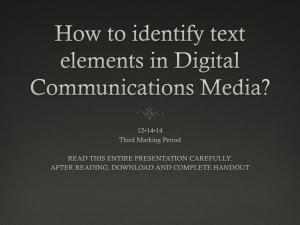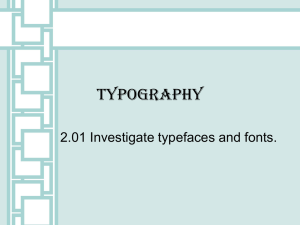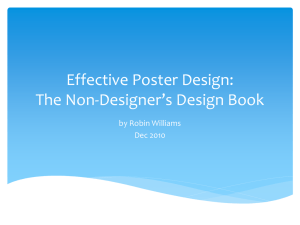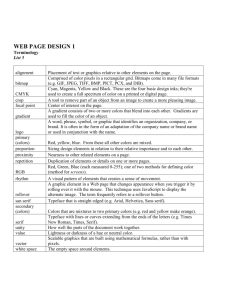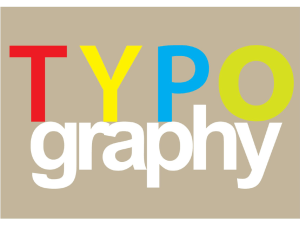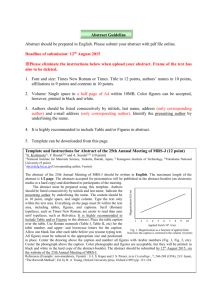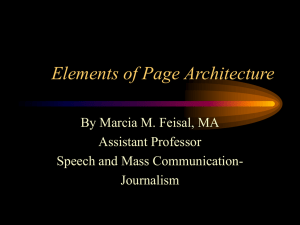Fonts
advertisement
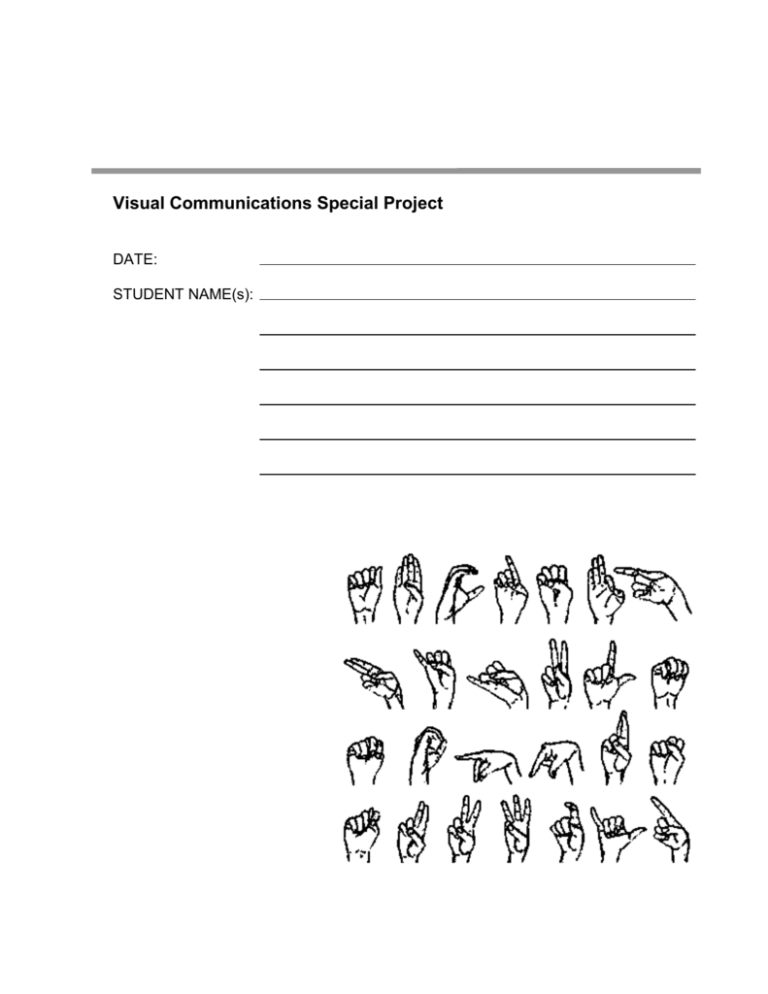
Visual Communications Special Project DATE: STUDENT NAME(s): Visual Communications Project 2 Visual Layout - Type Objectives Investigate the impact that type has on a visual communication Study some classifications of type The visual layout of text is very important: it determines the initial response of the reader to the text, and the layout of the text tells the reader about its structure. The reader's initial response is subtle, determined by the appearance of the font, its size, the number of words on a line and the number of lines on a page, the consistency in using graphical elements, and other typographical considerations. Skill Level I Fonts as Communicators (Materials from fonts.com and Bert Plat.) Type is the ship on which your message sails. Choose a bad ship and your message will sink to the bottom of the data ocean, never to be seen again. Personality isn't limited to persons. Movies, comic strips and text documents have personality too. Is it funny? Serious? Difficult or easy? Is it lengthy? Those are all attributes assigned in the first few minutes. More importantly, based upon the perceived personality the audience may decide whether to consume it or not. So what is a bad typeface? That depends on your message. Typefaces evoke emotions, either by design or by convention. For the fonts listed below, write a suitable use for each: Skill Level II Classifications of Fonts (From Jacci Bear's Desktop Publishing Glossary) To create a good text layout, you need to know when to use different styles of type. It is helpful to know the differences between typeface classifications. Typefaces are categorized by appearance. There is no single, agreed-on standard of classification--you will see many different systems in use. Within a classification system, many fonts also fall into more than one category. Serif fonts: A serif is the little extra stroke found at the end of main vertical and horizontal strokes of some letterforms. Some are subtle and others may be quite pronounced and obvious. In some cases serifs may aid in the readability of a typeface. Serif refers, in general, to any style of type that has serifs. Some of the main classifications of Serif type are: Blackletter, Old Style, Modern, Slab Serif, Transitional, and Informal. Fonts in each classification share certain similar characteristics including the shape or appearance of their serifs. Sans serif: Type which does not have serifs -- the little extra strokes found at the end of main vertical and horizontal strokes of some letterforms -- are called sans serif (without serif). Within sans serif there are five main classifications: Grotesque, Neo-Grotesque, Geometric, Humanist, and Informal. Typefaces within each classification usually share similarities in stroke thickness, weight, and the shapes of certain letterforms. Although there were some sans serif typefaces in the 1800s, the 1920's Bauhaus design movement popularized the sans serif style. Also Known As: Lineal(e), Grotesque, Neo-Grotesque, Geometric, Humanist, Gothic (not Blackletter Gothic) Examples: Arial, Helvetica, Verdana, Futura, Univers, and Franklin Circle which of the following examples are serif fonts, underline which are sans serif fonts: Of the three major type classifications of Western typography, Roman is the style in widest use. The others are Blackletter and Italic. Roman Traditionally, Roman is a serif face based on the style of ancient Rome and is the typical classic serif of today. However, Roman also refers to any upright typeface (as opposed to italic, slanted, or script), even sans serif faces. Blackletter Based on early written forms, Blackletter is a style of typeface that features elaborate thick to thin strokes and serifs. The Gutenberg Bible, the first book ever printed with movable type, was set in a Blackletter typeface to mimic the manuscript writing of the time. Most often seen on diplomas, certificates, formal invitations, and in the nameplates of some newsletters and newspapers. Also Known As: Text, Old English, Gothic (not Sans Serif Gothic) Examples: Black Forest, Linotext, Goudy Text, Wedding Text Italic While roman typefaces are upright, italic typefaces slant to the right. But rather than being just a slanted or tilted version of the roman face, a true or pure italic font is drawn from scratch and has unique features not found in the roman face. Most word processing and desktop publishing programs have an option to turn a roman font into italic. If a matching italic version is installed, this may work fine. However, if an italic version is not available, some programs will create fake italics by simply slanting the roman typeface. Venetian printer Aldus Manutius and his type designer, Francesco Griffo are credited with creating the first italic typeface -- the term italic paying homage to Italy where the style originated. Also Known As: Oblique, Tilted, Slanted Examples: There are three kinds of italic type: Unrelated or pure italic is based on 15th Century handwritten scripts; Related italic is designed to accompany or blend with a similar roman face; and Matching italic is created from the same design as a specific roman face. This also includes fake italic rendered by some software. Oblique generally refers to fake italic or to italic sans serif. Circle which are italic fonts: Old Style In typography, Old Style is a style of font developed by Renaissance typographers to replace the Blackletter style of type. Based on ancient Roman inscriptions, these fonts are generally characterized by low contrast between thick and thin strokes, bracketed serifs, and a left-leaning axis or stress. There are two groups of Old Style typefaces: Venetian (Renaissance) and Garalde (Baroque). Also Known As: Antiqua, Ancient, Renaissance, Baroque, Venetian, Garalde, oldstyle Examples: Garamond, Centaur, Goudy Oldstyle, Century Oldstyle, Palatino, Sabon Transitional The Antiqua or Old Style of type of the 16th and 17th centuries evolved into a style known as Transitional. Typefaces of this category are beautifully suited for text because of their regularity and precision. Serifs are thin, flat and bracketed There is medium contrast between thick and thin strokes. The axis of the round characters is vertical or less inclined than earlier. There is often a triangular or flat tip where diagonal strokes meet (such the base of a W), and the "s" is slightly pronounced. Also Known As: Modern Transitional Examples: Baskerville, Times New Roman, Bell, Perpetua Modern In typography, Modern is a style of typeface developed in the late 18th century that continued through much of the 19th century. Characterized by high contrast between thick and thin strokes and flat serifs, Modern fonts are harder to read than previous and later typestyles. Some later variations include the Slab Serifs with bolder, square serifs and the related Clarendon style with less contrast and softer, rounded shapes. Also Known As: Didone, New Antiqua, Moderne Examples: Bodoni, Didot, Bernhard Modern Roman Slab Serif Slab Serif is a type of serif font that evolved from the Modern style. The serifs are square and larger, bolder than serifs of previous typestyles. Considered a subclassification of Modern, Slab Serif is further divided into Clarendon, Typewriter, and Slab Serif (a separate sub-category of Slab Serif) styles. Slab serif typefaces were born out of the Industrial Revolution as a result of increased use of posters, billboards and other forms of advertising. Also Known As: Square Serif, Clarendon, Typewriter, Egyptian Examples: Clarendon, American Typewriter, Rockwell Script Typefaces in this category are those designed to resemble handwriting, with styles ranging from formal to whimsical. The characters of some script typefaces are connected. The first Script typeface was created by a Parisian printer in 1643. Today there is a large variety of Script typefaces available, many of which resemble handwriting created using different writing instruments such as a brush or calligraphic pen. Script typefaces should never be set in all capital letters and are generally reserved for announcements, invitations, greetings and advertisements. Circle which are script fonts: Novelty This classification includes typefaces of unusual and unique design that do not fit into other classifications. The name of the typeface often reflects the design. These are generally reserved for special purposes and are often most effective when used at larger sizes, such as for headlines, titles, and advertisements. Also Known As: Decorative, Display, Occasional Circle which are novelty fonts: Skill Level III The Story of Verdana In 1994, Microsoft began a typeface development project. Their goal was to produce a new family of sans serif typefaces as TrueType outline fonts which had optimal readability for computer screens. Matthew Carter was the type designer. Matthew Carter has worked with new and old technology in the type industry: cutting punches in steel for metal typefaces, editing bitmaps, and drawing outlines for photo and digital systems. One of his typefaces is Bell Centennial, which he designed as a bitmap in the late 1970’s. It was used to print phone books, notorious for being printed on poor quality paper at high speeds. He focused on the final product which people would read - three sizes for each of four weights of a sans serif typeface family. From bitmaps, Matthew “wrapped” outlines around them, which would in turn be produced as TrueType outlines. Since Verdana first shipped with Internet Explorer in 1996, it has become one of the most widely specified fonts in Web sites around the world, due to both the universal appeal of the design and the quality of the rendering. The team has since produced other widely used typeface families including the condensed cousins to Verdana: Tahoma and Nina and Matthew’s serifed family named Georgia. Verdana 18: The quick brown fox jumps over the lazy dog. Tahoma 18: The quick brown fox jumps over the lazy dog. Georgia 18: The quick brown fox jumps over the lazy dog. Which of the above typefaces would be best for persons with visual problems? Which of the above typefaces would be best for a child's book? Which of the above typefaces would be best to save paper? Looking back: What was the goal of this Special Project?
